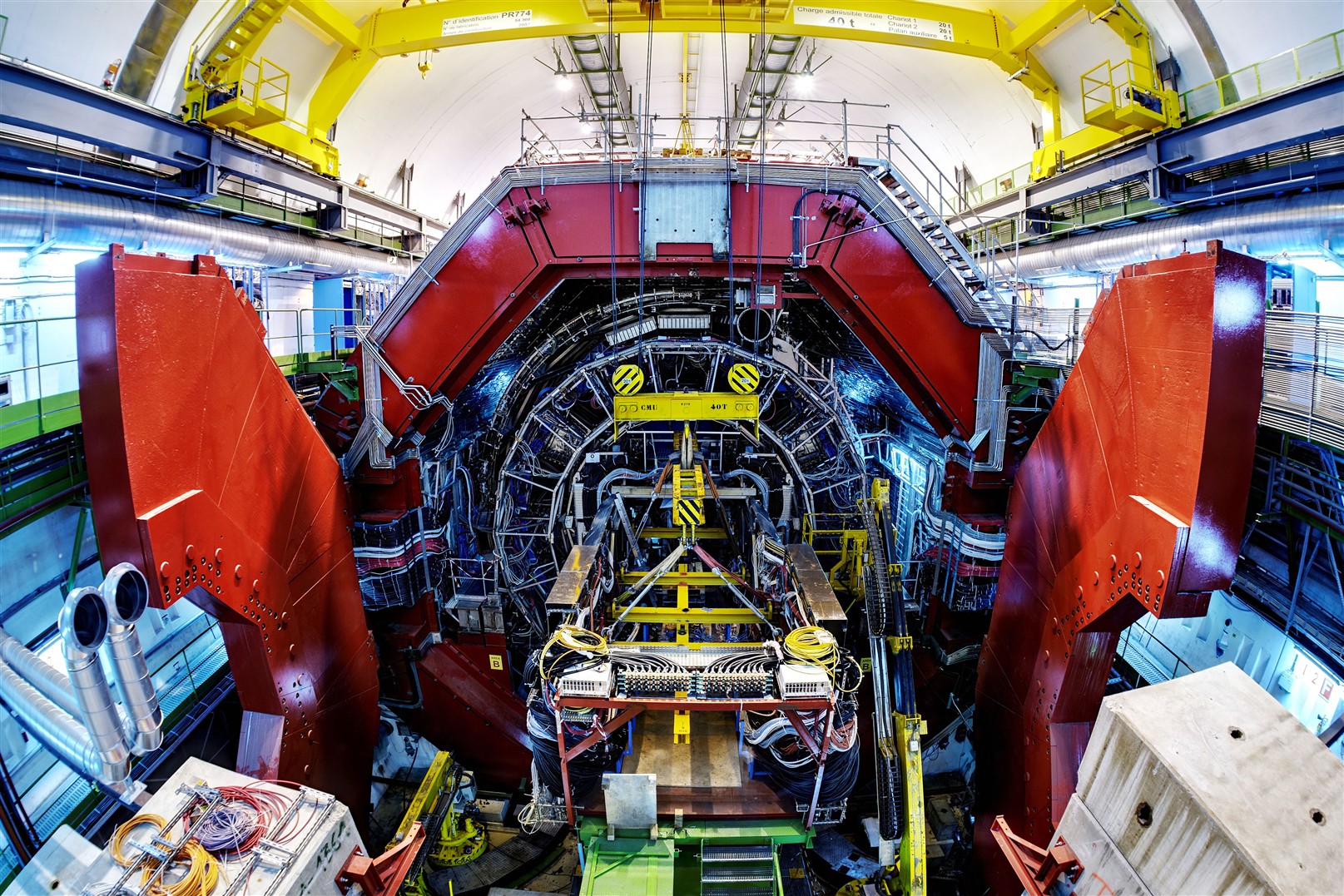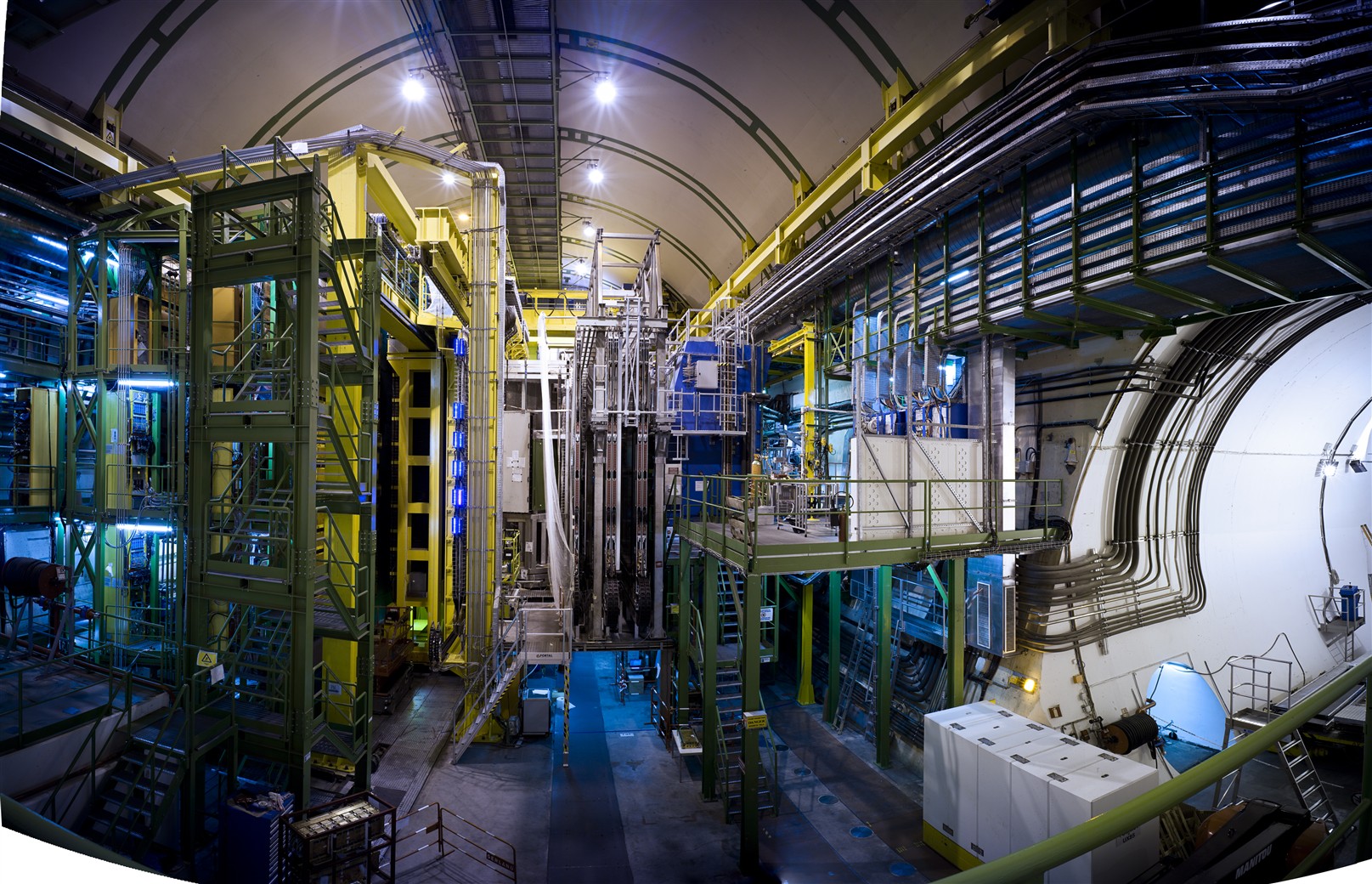ALICE & LHCb: refinements for the restart
Following the previous issue, the Bulletin continues its series to find out what the six LHC experiments have been up to since last September, and how they are preparing for the restart. Previously we looked at CMS and ATLAS; this issue we will round up the past 10 months of activity at ALICE and LHCb.
This year has given LHCb the chance to install the 5th and final plane of muon chambers, which will improve the triggering at nominal luminosity. This is the final piece of the experiment to be installed. "Now the detector looks exactly as it does in the technical design report," confirms Andrei Golutvin, LHCb Spokesperson.
"We also took advantage of this shutdown to make several improvements. For example, we modified the high voltage system of the electromagnetic calorimeter to reduce noise further to a negligible level. We also took some measures to improve the ageing behaviour of the outer tracker caused by radiation. And we replaced a few inefficient Hybrid Photo Devices (HPD) in the RICH detector in order to reach full performance.
Unlike the other LHC experiments it is not easy to align LHCb using cosmic rays. "The use of cosmic data is rather non-trivial for LHCb because our detector has a horizontal geometry," explains Golutvin, "and since it is located deep under the ground it is very challenging to select the ‘horizontal’ tracks, which are much less frequent."
"Nevertheless we succeeded in collecting sufficient cosmic data to synchronize timings of the big subsystems, like the outer tracker, the calorimeters and the muon chambers." Eventually all the LHCb detectors have to be synchronized to a nanosecond precision. In addition cosmic ray tracks are used to align the outer tracker spatially. However, close to the beam pipe are the small and fine granular detectors, the vertex locator (VELO) and inner tracker, "these are simply impossible to align using only cosmic rays," he adds.
Luckily enough LHCb is located very close to the LHC injection point and during the tests of the transfer line from SPS to LHC the beam is directed into a beam stopper, and produces muons that cross LHCb horizontally. "For us this is really useful," says Golutvin, "the particle flux is actually very dense, about 10 particles per square cm, and we use these tracks to align the vertex detector and the inner tracker to a few microns."
But there is also a downside to being located so close to the injection point. "We have to be very careful not to destroy the vertex detector during the injection procedure, so the VELO is built in two halves that can slide away from the beam to a distance of about 3 cm in order to be protected during injection," explains Golutvin. "It is very important to test the mechanism, which we did during the last injection test. In fact we turned it into a sort of competition - the people reconstructing the tracks were not told the distance between the two halves of the VELO and they had to work it out from the data. Some managed to work it out to a couple of microns, and were even awarded with chocolates." There will be at least one more of these test runs before the start up, which will allow further alignment improvements.
"Having finalized the work on the detector, the commissioning activities will continue until we get first collisions, " Goluvin continues. " We will also use the time left before the start-up to prepare for physics. There are several different phases in the start-up scenario of the LHC in the first year, so we want to work out how best to use the luminosity available during these phases. We are exploring the charm sector for instance, which would probably require smaller luminosity to be competitive with other experiments.
Videos of the injection test runs of both LHCb and ALICE are available on CERN’s YouTube channel: http://www.youtube.com/cern
Outreach
Before the cavern closed to the public, LHCb inaugurated their new exhibition at point 8 just before the first beam last September. "But with this period of shutdown we’ve actually had the chance to take many more visitors down to see LHCb," says Bolek Pietrzyk, LHCb’s Outreach Contact. "In fact, with the excitement of the start up, and the Angels and Demons film we’ve had more visitors than ever this year."
With both official CERN tours and LHCb’s privately arranged visits, so far in 2009 over 6500 people have visited the cavern at point 8. "And we are going to keep giving tours as long as possible, hopefully all the way until the end of October," adds Pietrzyk.
Even after the LHC restart there will still be plenty to see on the surface - in fact, this year another 6000 people visited point 8 without descending into the cavern. At the new exhibition visitors can see real parts of the detector and take a virtual tour. (You can see the exhibition panels here . LHCb also have a new brochure)
Being a dedicated antimatter experiment, LHCb enjoyed a lot of extra attention from the recent blockbuster film, Angels and Demons. With the public interest in antimatter, many LHCb physicists have found themselves with even more requests to give talks and lectures. "So we want to try and get together some interesting resources, like images and animations, so that people can use them when giving talks at universities, for example" explains Emma Stokes, who is creating the new presentations. "But we also want to make ‘kits’ available for school teachers with all these resources, plus instructions on how to build simple demonstrations out of things you can easily get hold of in the class room. For instance, using a magnet against an old cathode ray computer monitor to show how charged particles are bent in a magnetic field."

ALICE
Having already performed a lengthy cosmic ray test run, ALICE decided to immediately start consolidation work after the shutdown last autumn. "We wanted to use the additional time for improvements and upgrades," explains Paul Kuijer, ALICE Deputy Spokesperson, "for example, we realised that the access to the main tracking device, the TPC, was rather difficult, which could lead to unreasonably long service and repair times in the future, so we spent a lot of time moving all the cabling of the inner tracking system to give more space and better access." This was a major operation, running from October 2008 until July 2009. All cables and services have been re-tested and the inner tracking system is again on-line.
Future maintenance was pre-empted in other areas too, such as replacing a number of capacitors on the time projection chamber (TPC), which were suspected to have a reduced lifetime. The shutdown also gave ALICE the chance to install several new detector systems that were originally scheduled for after the first LHC run. Additional transition radiation detector (TRD) modules were installed and more of the Photon Multiplicity Detector (PMD) is now available, but the biggest new part is the new electromagnetic calorimeter (EMCAL).
The EMCAL, which is already partially installed, is a very recent addition to the ALICE design with funding only fully approved (by the US, France and Italy) in early 2008. Its installation means ALICE can now perform more extensive measurements of photons and neutral hadrons (which are not seen by ALICE’s charged-particle tracking system) as well as charged hadrons in the jets created when quarks and gluons recombine after having formed a plasma - crucial for determining the overall energy of the jets.
Early in 2009 the muon spectrometer took several weeks of cosmic data with which a first check of the internal alignment of the system could be made. However this is a tricky task since the muon spectrometer is designed to be sensitive to horizontally arriving muons only. Luckily, like LHCb, ALICE also had the chance to use ‘horizontal muons’ created during the testing of the LHC transfer system. Known as a TED run, particle bunches sent from the SPS through the transfer line are directed into a ‘beam stopper’ creating a shower of particles that could be seen in the ALICE detector (See the video on CERN’s YouTube channel).
"This was actually very useful," says Kuijer, "because last year we didn’t dare switch on all the detector during the TED run for fear of causing damage. But with the data from last year we could figure out the particle density. So two weeks ago when the LHC made injection tests we could switch on most of the trigger detectors, which allowed us to tune the relative timings," explains Kuijer. Data from the transfer line test was also used to align sub-detectors that are oriented such that they cannot be calibrated using cosmic rays, namely the forward detectors.
Before the eagerly awaited restart of the LHC the collaboration will start another new full-detector cosmic ray run, from mid August to mid October. "But this year we will be able to reach higher efficiency as we know how to operate the detector better. We’ve also developed an additional trigger derived from the time of flight (TOF) modules to facilitate triggering on muons." This test run will allow ALICE to verify the improvements and new detectors installed over the past 10 months and help the personnel prepare for continuous operation once the LHC restarts.
Outreach
This year has seen a big increase in visits to the ALICE cavern. "We must have had thousands of people visiting this year," said Despina Hatzifotiadou, ALICE Outreach Coordinator. "ALICE was never on the official visit itinerary, so it started with people just arranging visits for their friends and relatives, then progressed to their schools and universities, and it grew and grew, especially with the excitement caused by the first beam."
As with all the other LHC experiments, ALICE will be closed to the public when the LHC restarts, so there are also plans to extend the current exhibition space at point 2. "Once we’ve finished installing new detector parts, it will be much clearer what space is available, then we can start planning an extension to the exhibition, so that there are still things to see once the cavern is closed."


